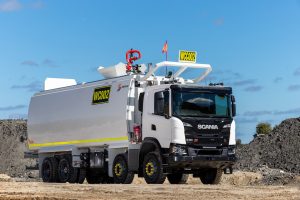WorkSafe QLD issued an incident alert after a water truck driver suffered fatal injuries. The cabin trapped the driver underneath the truck, after it rolled over on a construction site job in January 2021.
IMPORTANT

At the time of posting these findings were not yet confirmed. Investigations into the incidents are continuing to determine the exact cause.
Safety issues
Mobile plant, including water trucks, pose a number of risks to drivers and passengers. These include:
- plant operators and service personnel falling from earthmoving equipment during onsite inspection, maintenance or repairs. (Source – Worksafe Victoria)
- the plant colliding or contacting people or objects such as other vehicles or plant and energised powerlines
- the plant overturning
- objects falling on the operator
- The operator being ejected from the plant.
Ways to manage health and safety
Taking steps to manage risks is a condition of doing business in Queensland. Effective risk management starts with a commitment to health and safety from those who manage the business. If an incident occurs, you’ll need to show the regulator you’ve used an effective risk management process. This responsibility is covered by your primary duty of care in the Work Health and Safety Act 2011.
Possible control measures to prevent similar incidents
Use the hierarchy of controls to help decide how to eliminate and reduce risks in your place of work. The hierarchy of controls ranks types of control methods from the highest level of protection and reliability to the lowest. It’s a step-by-step approach to eliminating or reducing risks. You must work through the hierarchy of controls when managing risks and aim to eliminate the hazard, with the most effective control.
Employers and self-employed persons are required to control the risk associated with mobile plant, including the risk of drivers or passengers being ejected. Before operating powered mobile plant, the person with management or control of it must ensure:
Control the risk
- the vehicle selected is the right vehicle for the task
- weather, ground conditions and the intended travel pathway are inspected and assessed to identify any problem areas. For example sloping ground
- a seat belt, where fitted, worn
- ensure all occupants wear a seatbelt to keep them secured in the seat and protect them from serious or fatal injuries
- ensure all seat belts are in good working condition
- a suitable combination of operator protective devices for the plant is provided.
- ensure that plant driven to suit the environmental conditions.
- slow enough to retain control in unexpected circumstances
- reduce speed before turning or applying brakes
- use as wide a wheel track as possible when working on hillsides and sloping ground
- descend slopes cautiously, keeping the powered mobile plant in low gear to allow motor compression to act as a brake. Watch out for ditches, embankments, and depressions – unstable banks can cause rollovers
- Read and follow the manufacturer’s operating instructions. For older items of mobile plant where operating instructions are not available, a competent person should develop operational procedures and instructions for use.
- not allow untrained or inexperienced people to operate the vehicle, particularly in unfamiliar or high-risk terrain or for unfamiliar tasks.
System of work
PCBUs must also provide a system of work that includes effective communication, with workers in remote or isolated locations. Furthermore, when working in remote areas and/or working alone, always let someone know where you are working and importantly when you expect to return.
For hazards similar to this particular incident, PCBUs must first consider controls that most effectively eliminate the risk or, where not reasonably practicable, that minimise the risks. Hazards such as the operator being thrown from the cab of the mobile plant may also be minimised by implementing administrative controls, so far as is reasonably practicable. Administrative controls can include:
- information, training, instruction, or supervision necessary to control the risks associated with plant
- keep all operating manuals and instructional material provided by the manufacturer showing how to correctly operate and maintain the plant
- training programs should be practical and ‘hands on’ and take into account the particular needs of workers like literacy levels, work experience and specific skills required for safe use of the plant.
- ensuring worker training, experience and competency aligns with the requirements and complexity of the task.
Minimise remaining risk
Minimise remaining risk with suitable personal protective equipment. For example:
- the use of hard hats, steel cap boots and high visibility vests
- safety footwear should be:
- suitable for the type of work and environment
- comfortable with an adequate non-slip sole and appropriate tread
- checked regularly to ensure treads are not worn away or clogged with contaminants.
Administrative control measures and PPE rely on human behaviour and supervision, and used on their own, tend to be least effective in minimising risks. Regularly review the control measures you put in place to make sure they work as planned.
More information
- How to manage work health and safety risks Code of Practice 2021 (PDF, 0.65 MB)
- Managing risks of plant in the workplace Code of Practice 2021 (PDF, 1.67 MB)
- Managing the work environment and facilities Code of Practice 2021 (PDF, 0.57 MB)
- Mobile plant
- Preventing falls from earthmoving equipment – Worksafe Victoria
- To Read More about Scania Water Trucks & Scania Safety.

